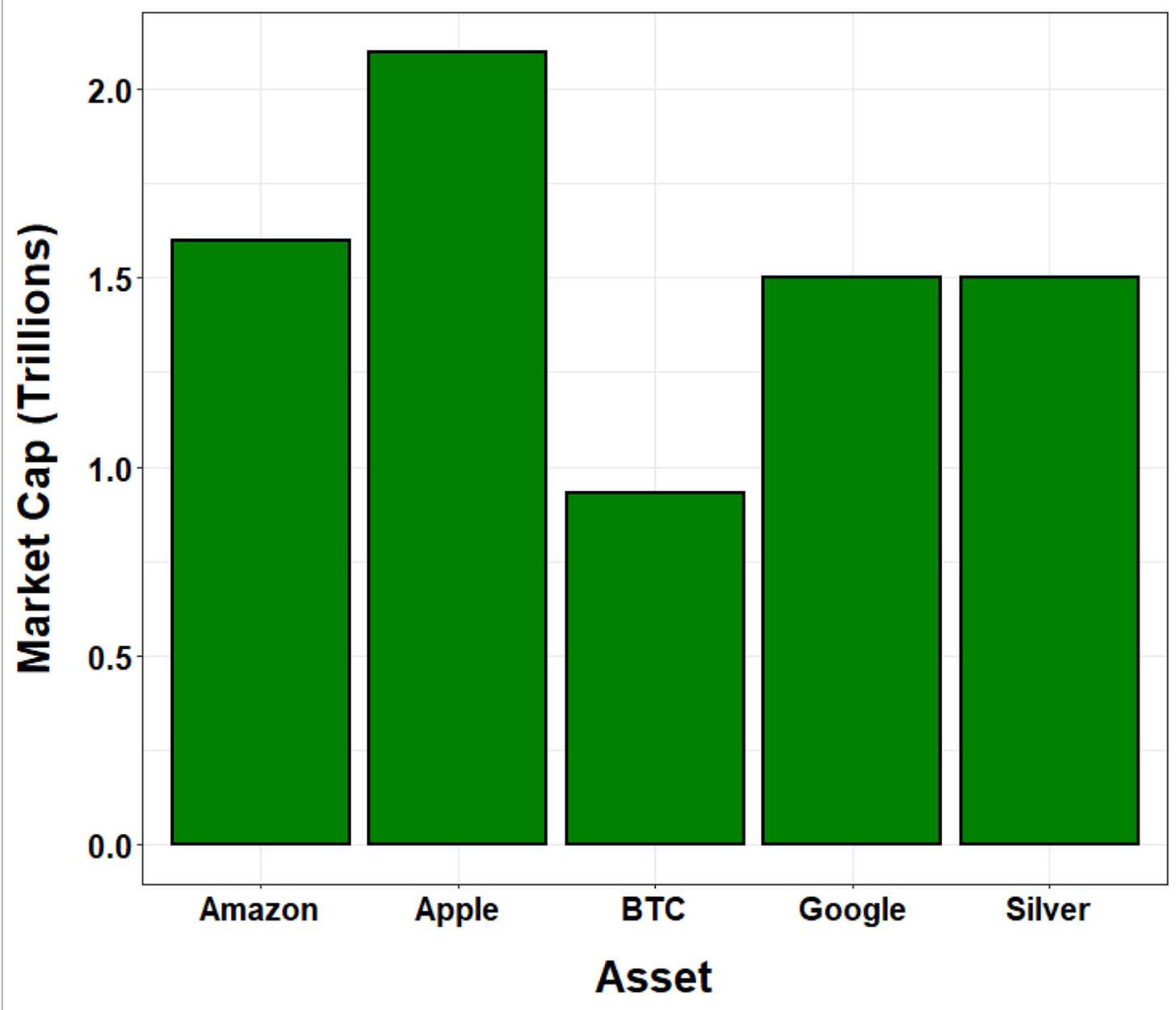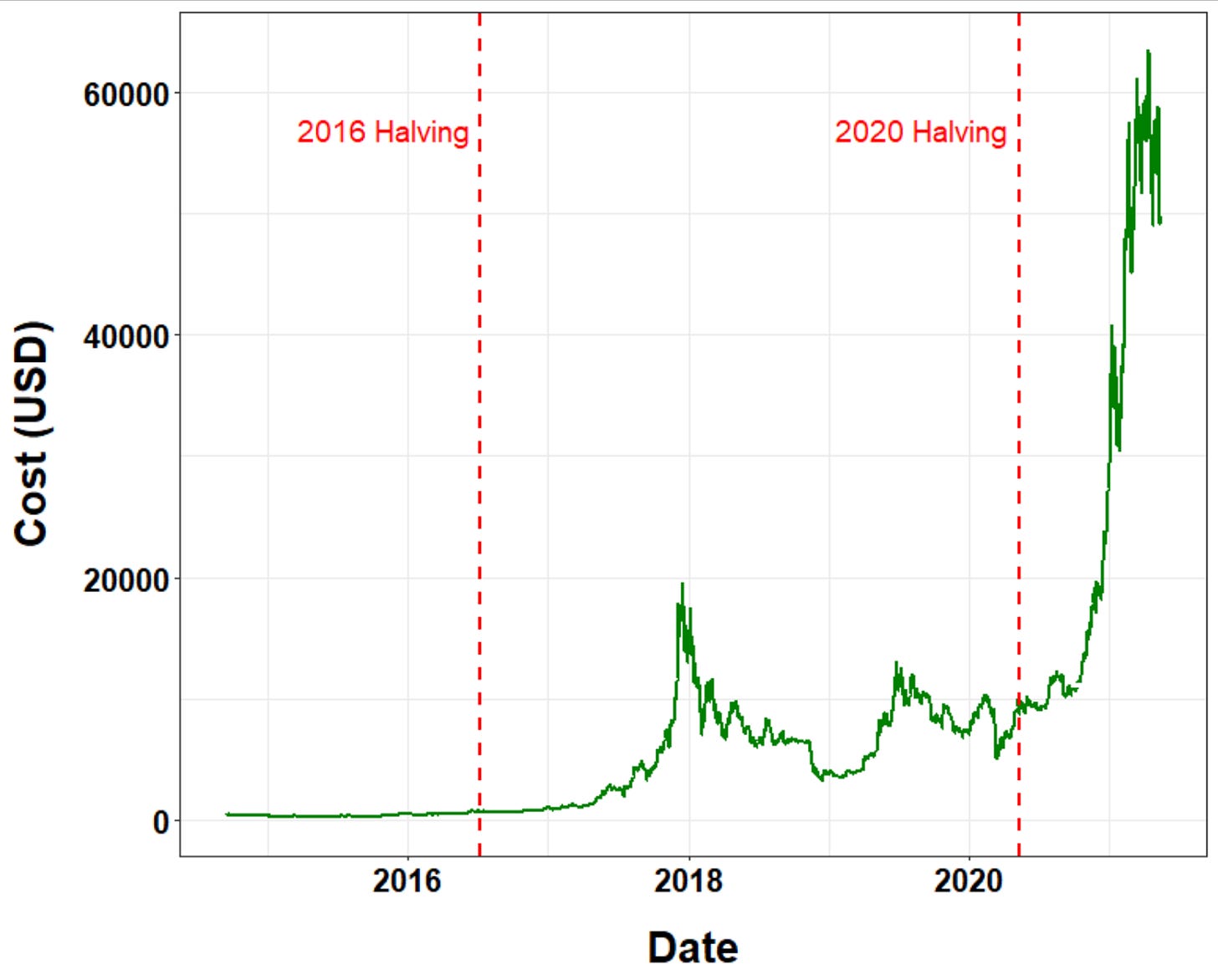In our Friday series, we take a deep dive into different asset investments. The first asset we’re covering - which we will stick with over the next several weeks - is Bitcoin (BTC). Our goal with this weekly series is to familiarize readers with BTC and to address common anti-BTC arguments. For full disclosure, Brandon and Daniel are strong believers in Bitcoin and both have allocated portions of their portfolios to BTC (HODL baby).
Why is the price so high?
At the time of this writing (5/13/2021, ~9:21 PM EST) the price for a full bitcoin is $50,129 USD. When introducing newcomers to BTC, one of their first responses is typically: “it’s too high…I feel like I missed my opportunity!” In fact, relative to other major investment vehicles, Bitcoin is still small. The overall market cap for Bitcoin puts it at 9th largest in the world, behind precious metals like gold and silver, and major corporations like Google, Amazon, and Apple, to name a few. Particularly important is BTC’s market cap relative to silver - a precious metal that derives much of its worth serving as a store of value. As will be discussed later in this article, BTC also appears to be gaining steam as a store of value rather than a transactional currency (although this is changing rapidly with new technology such as Lightning Network). Because of this, the most relevant comparisons are likely those made against silver and gold.
Unlike other investment vehicles, BTC has a hard capped limit on production. Whereas companies can create new products and precious metals like gold and silver can continue to be mined (theoretically there is a limited supply, but we don’t know exactly what that limit is), Bitcoin has an absolute hard cap. Written into the source code is a hard rule that only 21 million bitcoins will ever exist. The known maximum supply of bitcoin – as well as the open source infrastructure that allows anyone, at any time, to know how many bitcoins are in circulation – prevents inflation and makes each new coin more valuable. This, as well as the built-in “halving” events described below, make BTC a strong hedge against inflation and thus, a strong store of value.
On top of the hard cap are built-in “halving” events. As we described in the first part of this series, the “halving” events are programmed into the Bitcoin protocol and cut the amount of bitcoins that can be mined in half as transactions accumulate on the blockchain (halving events occur after every 210,000 blocks are mined). Essentially, halving events serve the important function of artificially reducing inflation, but they also act as a BTC supply diminisher. Assuming the BTC market is filled with individuals buying and holding BTC (HODLers), if the number of new coins entering circulation is cut in half, the supply will plummet and demand will skyrocket. This appears to be what happened following previous halving events, where bull runs ensued and the price of BTC rose rapidly. The last BTC halving event occurred in May 2020 and we’re still experiencing the bull run.
The open source nature of BTC also allows individuals to view - in real time - how long coins are being held in individual wallets. This allows investors to gauge how bitcoins are being used by the market. If coins are being bought and held for long periods of time, investors can assume that the market is treating the coins as a store of value. If coins are being bought and sold after short holding periods, then investors can assume that the market is treating the coins as a “get rich quick” method. In general, the open source nature of BTC is a massive strength of the technology in that it provides more information for investors to gauge actual bitcoin worth.
So, back to the original question: why is the price of BTC so high? The production of new coins is slowing (fewer new coins entering the market) at the same time that individuals and institutions are buying and HODLing coins. This combination keeps the supply of BTC low, which drives up its value. Remember that half of this equation is hard coded into BTC (artificially reduced circulation of new coins). The other half of the equation relies on individuals and institutions to view BTC as a worthwhile, long term investment. This appears to be happening, as institutional players like MicroStrategy continue to add and hold large amounts of BTC to their portfolios. If this trend continues, expect the price of BTC to continue to rise.
So...have I missed the boat?
Answer: No, the boat is right in front of you! Here’s why...
You now know that BTC supply is hard capped and programmed to gradually reduce in supply, driving demand up and reducing potential for inflation.
BTC is now receiving institutional backing from large companies and even governments, which will only encourage further growth and adoption.
New so-called second layer technologies are evolving quickly and will likely usher in an era of highly transactional BTC (shifting it away from a store of value into a fully transactional currency).
Think seriously about #3. Some of the smartest people in the world are working on this technology. That has to count for something.
Although the price of a single bitcoin is quite large, each coin itself is divided into 100,000 satoshis or “sats” as many in the Bitcoin community call them. This means that you can purchase as little as 1 satoshi at a time so you can get a part of a Bitcoin for less than $1! In other words, you don’t need to have a lot of money to begin investing in BTC!
Going forward
As we said in our introduction, we plan to address several arguments against BTC, one at a time, over the next several weeks. We hope that our weekly posts will encourage readers to learn more about this emerging technology.
Common arguments against BTC:
The price is too high (“I’ve missed the boat”)
BTC uses too much energy
BTC is too volatile
BTC is not physically backed by anything
BTC is used primarily by criminals for illegal activity
BTC is not a transactional currency (cannot be used to buy everyday items)
Governments will not allow it or will heavily regulate it
It’s easy to lose access to BTC wallet
Happy Friday everyone - get after it this weekend!
Brandon and Dan
Disclosure: The authors of this writing hold positions in cryptocurrency mentioned in this article. That cryptocurrency is Bitcoin. The article was written by Daniel Kuhman and Brandon Keys, and it expresses the author's own opinions. They are not receiving compensation for it. The information presented in this article is for informational purposes only and in no way should be construed as financial advice or recommendation to buy or sell any stock or cryptocurrency. Brandon and Daniel are not financial advisors. We encourage all readers to do further research and do your own due diligence before making any investments.





